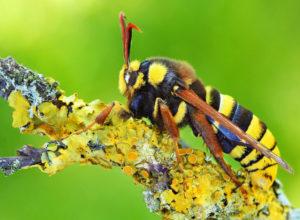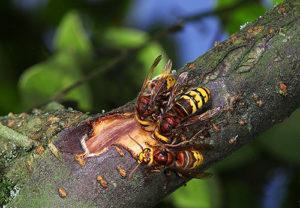Insect Nine - giant hornet
One type of wasp is the hornet. The insect is large in size and color. Among all the representatives, it is worth highlighting the Siberian variety.
Content
Description of the Siberian hornet
This is the largest one. Males are 28mm and females are 35mm. Their difference lies in the structure of the body. The ovipositor changed and became a sting. In males, the sting is absent.
You can call this variety one of the most beautiful. Chest black. Belly with black and orange-gold stripes. The cheeks with the back of the head have a red tint in females. In males, these areas are orange. The front of the head is yellow. Paws brown-red.
Habitat
This species lives in Europe. The exceptions are the northern and southern regions. Most widespread in:
- Kazakhstan;
- Ukraine;
- China (eastern part);
- RF;
- Siberia;
- North America.
Life cycle
With the advent of spring, the search for food begins and the survey of the territory in search of a suitable place. For the erection of the first honeycomb, the uterus is engaged in chewing the bark of a tree. Wood is a building material. On its own, the uterus manages to equip up to 50 cells.
The place for the nest is chosen by the queen. It is she who is engaged in the construction of the first honeycombs. The uterus lays eggs, and after a while the first working individuals appear.
The place for the nest is chosen by the queen. It is she who is engaged in the construction of the first honeycombs. The uterus lays eggs, and after a while the first working individuals appear.
The queen lays hundreds of eggs. Unfertilized eggs produce males, while fertilized eggs produce females. To overwinter, the uterus needs a supply of nutrients. This is possible thanks to active nutrition.
Individuals live in colonies. Their nests are round. They look like bee hives. They often build nests in trees. It is in limbo.
Worker hornets serve the uterus and larvae. Also continue to build a nest. Thanks to joint participation and the correct distribution of functions, the number of individuals increases.
Each individual has its own task. Some are feeding the larvae. Part is construction. The rest are guarding the nest. In a dangerous situation, they give an alarm signal. Hornets spend the night in the nest. During the day, each individual is busy with his work.
By August, the colony consists of several thousand insects. This is the most favorable period for mating. Females leave their family, looking for a place for wintering and a new hive. Male individuals die with the onset of cold weather. Females die before the start of the second winter. It is worth noting that predators and people destroy a huge number of hornets.
By November, there is no one in the hive. The worker hornets are dying. Insects do not settle in the nest for the second time. The surviving hornets build a new nest in the spring. Wintering place - cracks, walls of buildings, bark, hollow.
In winter, there is a period of diapause. It is characterized by a slowdown in metabolic processes. Diapause is facilitated by a decrease in air temperature and a decrease in the duration of daylight hours.
Diet and nutritional habits
Adult hornets eat plant foods. They prefer pollen from flowers, mature fruits and berries, bark of young branches.
The larvae need animal protein to form. Adult hornets prey on insects and feed offspring with minced meat. In response, the larvae secrete sweet droplets that hornets love.
The benefits of Siberian hornets
The benefit of insects is to eat locusts, flies, wasps, aphids, psyllids, ticks. Thanks to the destruction of pests, it is possible to save the crop.
First aid for a bite
Symptoms of an allergic reaction to a bite include:
- elevated temperature;
- severe headache;
- shortness of breath;
- pain in the abdomen.
After a bite, do not look for a sting. It remains in rare cases when the insect was killed at the time of the bite. Poison is allowed to be sucked out of the wound. However, this does not guarantee a 100% effect.
A few tips:
- treat the damaged area using citric or acetic acid;
- washed with soap;
- re-treat the bite site with hydrogen peroxide or an alcohol-containing solution;
- apply a sugar cold compress;
- take an antihistamine;
- consume large amounts of liquid;
- in case of deterioration of health, call an ambulance;
- from folk remedies, it is appropriate to use dandelion or plantain juice, a solution with garlic or onions.
Conclusion
The Siberian hornet is distinguished by a beautiful color from other relatives. It is not aggressive and does not pose a threat to people. For no apparent reason, it is forbidden to destroy nests, as insects are real helpers in garden plots.
Previous
